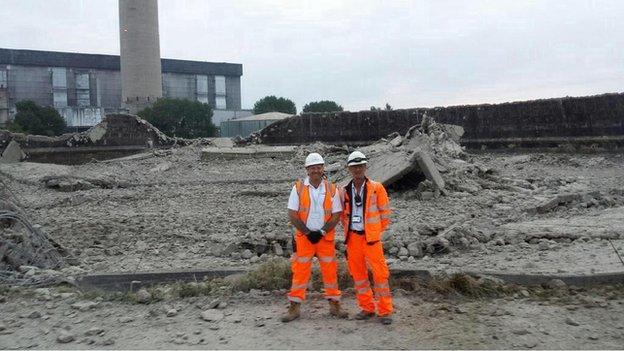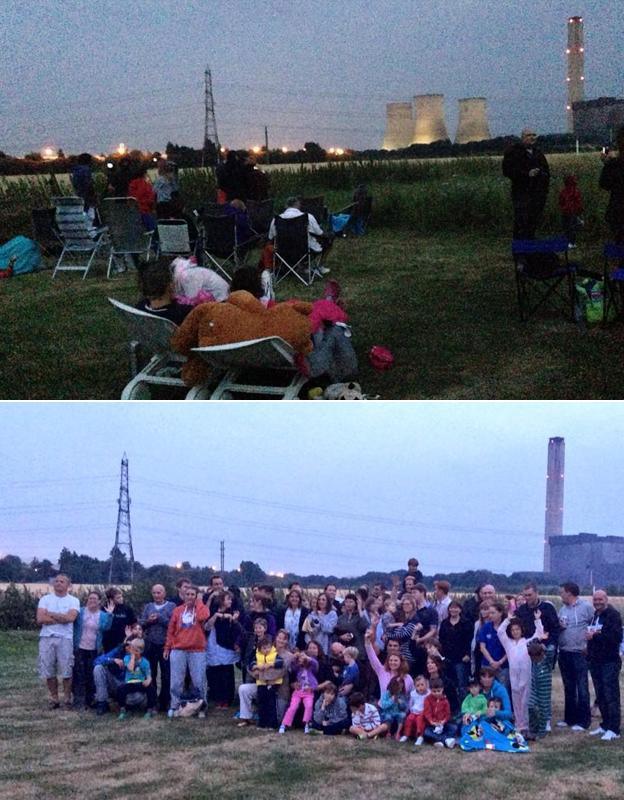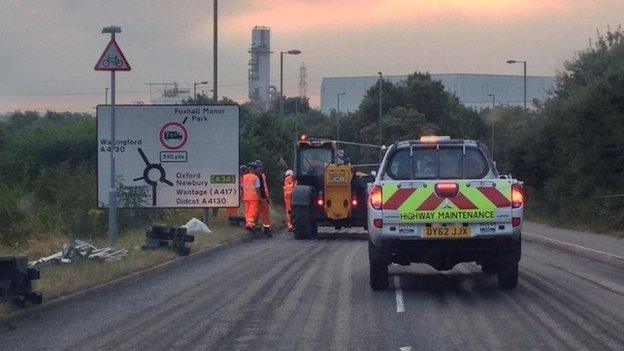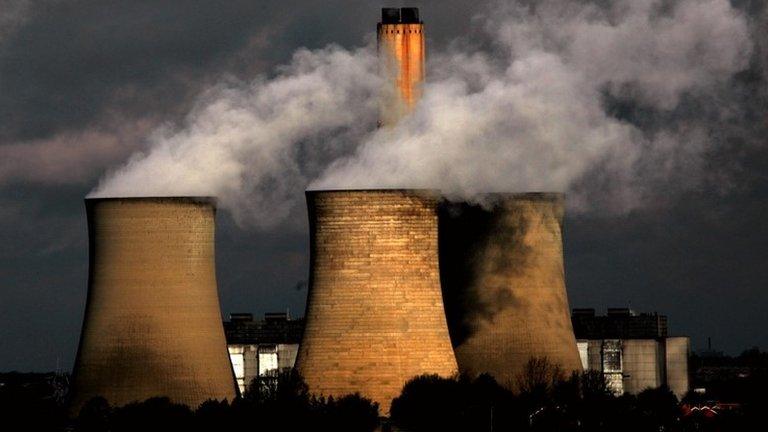Didcot power station towers demolished
- Published
Kate Hartwright from Didcot said it looked like the towers "were never there"
Three enormous cooling towers at the disused Didcot A Power Station in Oxfordshire have been demolished.
The blast, conducted with more than 180kg of explosives, flattened 36,000 tonnes of material in seconds and was streamed live online.
Hundreds of people gathered to watch the towers come down at 05:01 BST, despite warnings of a huge dust cloud.
The decision to carry out the demolition before sunrise was criticised by some residents.
The coal-fired power station ceased generating in March last year after dominating the skyline around the town since 1970.

Hundreds of people stayed up overnight to view the demolition from afar

The demolition team said they were pleased with the operation

Hundreds of people camped out overnight to see the towers disappear from the landscape
Mark Coleman, managing director of demolition firm Coleman and Company, tweeted, external: #DidcotDemolition, external well done to all involved. A professional textbook job. Thank you to all the locals. I hope you enjoyed it #teamwork
Many people camped out all night or got up early to watch the towers come down online, while #DidcotDemolition quickly became a trending topic on Twitter.
Gilliam Miles said: "Up at 2am and watched it from Ladygrove with hundreds of others - emotional moment. Will miss them."
Tina Banham said: "They went down so quickly - we were watching a water vole whilst waiting in Appleford, heard the explosion and they seemed to be down in seconds. Could have missed it had explosion not been so loud."
Stuart Kerry added: "I saw them being built when I was young and now have seen them come down via the internet live here in the USA."

Great British Bake Off contestant Christine Wallace made an edible tribute to the towers
Last year's Great British Bake Off quarter-finalist, and Didcot resident, Christine Wallace had made her own edible tribute to the towers before she watched them crumble.
She told BBC Radio Oxford: "My heart was thumping, all our hearts were thumping, just waiting to see what was going to happen.
"But then, in a second, what was there in front of us was no more. It was very moving actually."
Spectators had been advised to stay away from the "difficult to access" site and watch the event online instead.

At the scene: Katharine Da Costa - BBC Oxford
Spectators had started arriving at 22:00 on Saturday and many had been up all night by the time the towers came down.
Renditions of The Final Countdown rang out from the crowd as the anticipation grew.
After dominating the skyline for more than 40 years - the towers were reduced to rubble in under 10 seconds.
There were cheers and applause as many captured the historic moment on mobile phones and cameras.
Some witnesses said it was worth the wait and they were sad to see them go - others however felt the whole thing was a bit of an anti-climax.

For those determined to witness the event, Earth Trust opened its car park at Wittenham Clumps, while First Great Western also offered free parking at its Foxhall Road car park.
Residents wanting the explosion to take place in the daylight "for everyone to see" had set up a Facebook page and petition, which received more than 3,000 signatures.
But Guy Esnouf, NPower's director of communications, said experts including the Health and Safety Executive, Thames Valley Police and Network Rail had advised an early time.
He said: "We had 180kg of high explosives. That is an awful lot and you clearly don't want people and explosives near together. Safety has to come first."
Following the explosion, a clean up operation has started to clear the area of dust, including the nearby railway line.
The demolition firm said roads and the railway were clear by 07:00.
Homes and gardens being covered in dust had caused concern among some local residents living in nearby Foxhall Manor Park.
But Kieran Conarty from Coleman and Company said there would be "a series of jet washes to clean footpaths, buildings, roofs".
"Behind that there will be a series of road sweepers and behind that will be a series of operatives literally picking up the pieces."

Didcot A : Form and aesthetics
•The 2000 MW coal-fired power station (now also gas-fired and biomass fuelled) was constructed between 1965 and 1974
•The towers stood at 375 ft (114m)
•Each tower was designed to cool 9 million gallons of water per hour
•The consultant architect was Frederick Gibberd, who also designed Liverpool's Metropolitan Cathedral
•Gibberd designed a scheme that would maintain the wide views across the Vale of the White Horse
•As the site was in a flat valley, Gibberd devised "earth hedges" to screen the coal yard from the main railway and security fence
Source: English Heritage


Cleaners were sent out to clear dust from the surrounding areas
- Published27 July 2014

- Published23 March 2013

- Published25 July 2014

- Published29 June 2014

- Published27 June 2014

- Published23 June 2014
